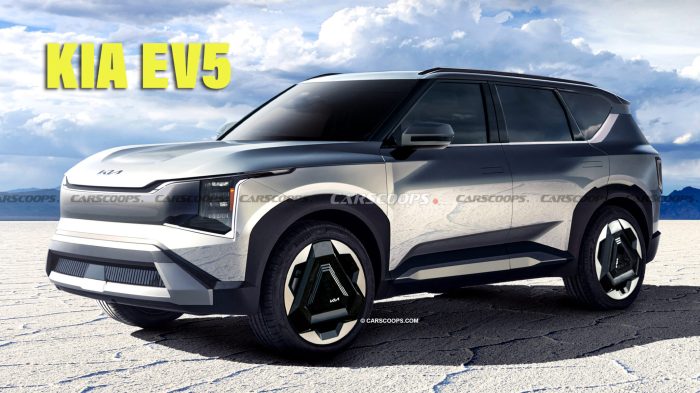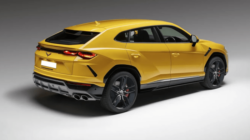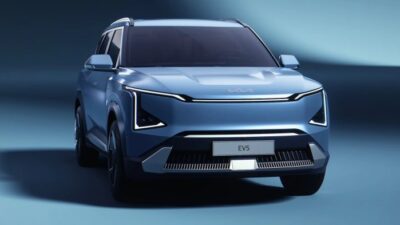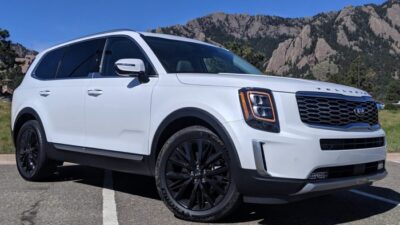Full-Size SUVs 2025 sets the stage for a revolution in the automotive industry, showcasing cutting-edge technology, sustainable design, and enhanced performance metrics that redefine the driving experience.
As we delve deeper into the world of full-size SUVs, we uncover a landscape of innovation and progress that promises to shape the way we commute and adventure in the coming years.
Overview of Full-Size SUVs in 2025

Full-size SUVs have a rich history dating back to the mid-20th century when they were originally designed for off-road capabilities and rugged use. Over the years, they have evolved to become popular family vehicles known for their spacious interiors and powerful performance.
As we look ahead to 2025, the automotive industry is gearing up for a revolution in premium luxury cars. With cutting-edge technology and innovative design, the Premium Luxury Cars 2025 are set to redefine the concept of luxury on the road.
Brief History of Full-Size SUVs
Full-size SUVs gained popularity in the 1990s and early 2000s as a symbol of luxury and status. Brands like Chevrolet, Ford, and GMC introduced iconic models such as the Chevrolet Suburban and Ford Expedition, which set the standard for full-size SUVs.
Imagine driving a car that not only exudes luxury but also comes equipped with advanced features that enhance your driving experience. The Luxury Cars with Advanced Features 2025 are designed to impress even the most discerning drivers.
Current Market Trends for Full-Size SUVs
- Increased Demand: Full-size SUVs continue to be in high demand due to their versatility and ability to accommodate large families.
- Hybrid and Electric Variants: Manufacturers are increasingly offering hybrid and electric options to cater to the growing demand for eco-friendly vehicles.
- Advanced Technology: Full-size SUVs now come equipped with state-of-the-art technology features such as advanced infotainment systems, driver-assist technologies, and connectivity options.
- Luxury and Comfort: Luxury features such as premium materials, customizable interiors, and enhanced comfort options are becoming standard in full-size SUVs.
Key Features of Full-Size SUVs, Full-Size SUVs 2025
- Large Seating Capacity: Full-size SUVs typically offer seating for seven to nine passengers, making them ideal for large families or group travel.
- Powerful Performance: These vehicles are equipped with robust engines capable of towing heavy loads and navigating challenging terrains.
- Spacious Cargo Area: Full-size SUVs provide ample cargo space, perfect for transporting luggage, sports equipment, or groceries.
- Off-Road Capabilities: Many full-size SUVs come with all-wheel drive or four-wheel drive systems, allowing them to tackle off-road adventures with ease.
Technology Trends

The automotive industry is rapidly evolving, and full-size SUVs are at the forefront of technological advancements. By 2025, these vehicles are expected to integrate cutting-edge technology to enhance performance, safety, and overall driving experience.
Integration of AI and Autonomous Driving Features
AI and autonomous driving features are set to revolutionize the way we interact with full-size SUVs. With the implementation of AI-powered systems, these vehicles will be able to analyze road conditions, predict driver behavior, and make real-time adjustments to ensure a safe and smooth ride. Autonomous driving features will also play a significant role in reducing accidents and improving overall road safety.
- AI-powered navigation systems will provide real-time traffic updates and suggest optimal routes to avoid congestion.
- Autonomous parking capabilities will make parking in tight spaces a breeze, enhancing convenience for drivers.
- Advanced driver-assist systems will offer features like lane-keeping assistance, adaptive cruise control, and automatic emergency braking to enhance safety on the road.
Electric and Hybrid Technologies
The shift towards electric and hybrid technologies is reshaping the future of full-size SUVs, with an emphasis on sustainability and efficiency. By 2025, these vehicles are expected to offer a range of electrified options to cater to environmentally conscious consumers.
- Electric full-size SUVs will provide emission-free driving experiences, reducing the carbon footprint and contributing to a cleaner environment.
- Hybrid full-size SUVs will combine the benefits of gasoline engines with electric motors to improve fuel efficiency and reduce overall emissions.
- Regenerative braking systems will help recharge the battery while driving, maximizing energy efficiency and extending the driving range of electric and hybrid full-size SUVs.
Design and Sustainability

As we look towards the year 2025, the design of full-size SUVs is undergoing a significant evolution to meet the changing demands of consumers and regulations. Alongside design changes, sustainability has become a key focus for automakers in the full-size SUV market, with initiatives aimed at reducing environmental impact.
Design Evolution of Full-Size SUVs
The design evolution of full-size SUVs towards 2025 is characterized by a shift towards sleeker and more aerodynamic profiles. Automakers are incorporating advanced technologies to improve fuel efficiency without compromising on the spaciousness and comfort that SUVs are known for. LED lighting, panoramic sunroofs, and innovative grille designs are becoming standard features, enhancing both aesthetics and functionality.
Sustainability Initiatives
- Many automakers are investing in sustainable practices within the full-size SUV market, such as using recycled materials in vehicle construction and implementing eco-friendly manufacturing processes.
- Hybrid and electric options are becoming more prevalent, offering lower emissions and reduced reliance on fossil fuels.
- Some manufacturers are exploring the use of bio-based materials in interior components, reducing the environmental impact of vehicle production.
Eco-Friendly Materials and Manufacturing Processes
Automakers are increasingly turning to eco-friendly materials and manufacturing processes to reduce the carbon footprint of full-size SUVs. This includes the use of recycled plastics, sustainable fabrics, and natural fibers in vehicle interiors. Additionally, advancements in production techniques such as 3D printing and water-based paints contribute to a more sustainable manufacturing process.
Performance and Efficiency: Full-Size SUVs 2025

In 2025, full-size SUVs are not only delivering impressive performance but also focusing on enhancing fuel efficiency and reducing emissions to meet stricter environmental regulations.
Comparison of Performance Metrics
- Acceleration: Full-size SUVs in 2025 are expected to have faster acceleration times compared to their predecessors, thanks to advancements in engine technology and lightweight materials.
- Handling: Improved suspension systems and electronic stability controls contribute to better handling and maneuverability in newer full-size SUV models.
- Towing Capacity: With enhanced towing capabilities, full-size SUVs in 2025 can easily tow heavier loads, making them more versatile for outdoor activities and towing purposes.
Improving Fuel Efficiency and Reducing Emissions
- Hybrid Technology: Many full-size SUVs in 2025 are incorporating hybrid technology to improve fuel efficiency and reduce emissions. By combining an internal combustion engine with an electric motor, hybrids can achieve better mileage and lower carbon emissions.
- Engine Efficiency: Advanced engine designs and technologies, such as turbocharging and direct injection, are helping full-size SUVs in 2025 achieve higher fuel efficiency without compromising on performance.
- Lightweight Materials: The use of lightweight materials like aluminum and carbon fiber in the construction of full-size SUVs helps reduce overall weight, leading to improved fuel economy and lower emissions.
Impact of Alternative Fuel Sources
- Electric Powertrains: Full-size SUVs powered by electric powertrains are gaining popularity in 2025, offering zero-emission driving and lower operating costs. These electric SUVs provide impressive performance metrics while being environmentally friendly.
- Hydrogen Fuel Cells: Some full-size SUVs are utilizing hydrogen fuel cells as an alternative fuel source in 2025. These vehicles produce electricity by combining hydrogen with oxygen, emitting only water vapor as a byproduct and offering excellent performance and efficiency.
- Biofuels: Biofuels derived from renewable sources like plant oils and waste materials are being explored as another alternative fuel option for full-size SUVs. These biofuels can help reduce greenhouse gas emissions and enhance the sustainability of large SUVs.
In conclusion, Full-Size SUVs 2025 not only represents a shift towards a more sustainable and efficient future but also embodies the evolution of automotive engineering at its finest. The journey ahead is paved with exciting possibilities and advancements that are sure to captivate enthusiasts and casual drivers alike.
Looking further into the future, the Future Luxury Cars 2025 are set to push the boundaries of what we thought was possible in the world of luxury vehicles. Get ready for a whole new level of sophistication and performance.













